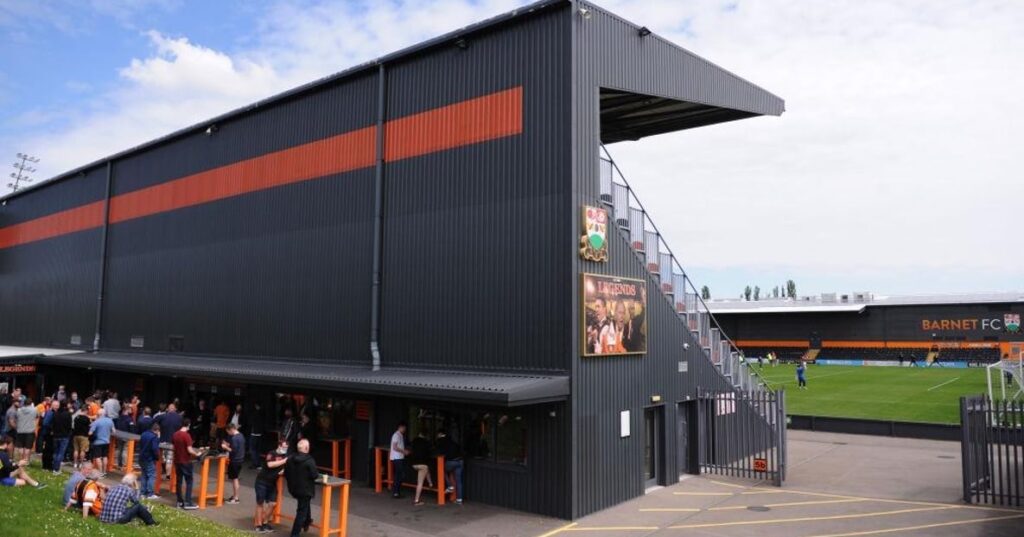© The Fan Experience Company 2023

The Fans Journey - Part 6: Outside The Venue
The phrase ‘hidden gem’ is usually associated with afternoon TV: the lovely villages by the seaside, those sepia tinged railway journeys, the secret Victorian kitchen garden or even a secluded spot where nature, in its full beauty, can be observed. By now, you’ve probably spotted that this is a flimsy preamble to our latest thoughts on fan experience. And you’d be right, for the ‘hidden gem’ we want to explore this time around is Non-League Football and, more specifically, everything that happens before you take your place by the side of the pitch.
By way of context, you already know that Non-League clubs are largely volunteer-run. Resources are thin. The recent cost of living crisis means that challenges like paying utility bills have gone from annoying to Herculean. Being from a North Durham pit village, I’m familiar with a culture of subsistence. There’s a joke that the late Bobby Thompson used to tell. A man knocks on the door. The tenant opens it and says, ‘come in and take a seat’. The caller responds, ‘I’m the bailiff. I’ve come to take them all.’

Mark Bradley
@fanexperienceco
Mark founded the Fan Experience Company in 2005 to build attendance growth and community engagement on the basis of improving fan experiences. He recently created FC Barcelona’s Barça Innovation Hub’s first fan engagement study certificate. The Fan Experience Company has undertaken more than 3,500 fan experience assessments in many countries for clients as diverse as The Danish Superliga, The EFL, The WSL / WC, United Rugby and Premiership Rugby.

Geoff Wilson
@fanexperienceco
Geoff runs his own Sports Consultancy, working with clients such as FIFA, UEFA, AFC and FIBA across the world. He is also on the board of Tourism Northern Ireland. You can follow Geoff on twitter @geoffwnjwilson connect on Linkedin at linkedin.com/in/geoffwnjwilson

Darren Young
@fanexperienceco
Darren joined the Fan Experience Company in 2017. He has an MBA with a background in customer service excellence having worked as a consultant in that field for a number of years. As well as being responsible for all of the assessment summary reports that are produced each season, he has also worked with a number of clubs on an individual basis, including Lincoln City, Walsall, Grimsby Town, Nottingham Forest and OH Leuven on projects ranging from staff development to supporter feedback surveys.
One of the messages that we regularly return to is that of Non-League Clubs ‘hiding their lights under a bushel’: forgetting to celebrate and promote those elements that make a match day so special (especially when compared to elite levels of the game). Central among these strengths is the pre-match experience and, in this blog, I want to describe the pre-match assets that the community game enjoys and urge it to tell its match day experience story more clearly and confidently.
Consider the differences between ‘outside the venue’ at Premier League game and the equivalent at a Non-League football match. Tickets are expensive and, on the whole, not that easy to come by. Travel often demands laser-sharp planning, a host of contingencies and an astronomical parking charge. The stadium car park is usually fully subscribed too. If you were to choose hospitality for, let us say, a family birthday, there will always be a cost: sometimes eye-wateringly high. Your dream of seeing your daughter enjoy the memory of a lifetime as a match day mascot is, at the vast majority of elite stadiums, just another way to extract money from fans. At least the Fan Zone is free, until you feel a bit peckish.
At Non-League football, you can park on site for free, if you arrive early enough and, if you do turn up a couple of hours before the game, you can usually watch most of the big lunch time game on TV in a welcoming and friendly free-to-enter hospitality area (the club house). Your daughter will lead the teams out – at no cost – and enjoy chatting to players after the game.
There are new concepts that are lifting the Outside the Venue experience to even greater heights. For example, Match Day Hosts are ensuring that new fans not only know how to get the best out of the day, but through their energy and pro-action are making it odds-on that those fans will return.
But how many clubs actually tell people about this? How many use these assets to attract more fans to games? How many make the comparison and then apply the coup de grace with the news that all of this is so affordable: even in a time of economic crisis?
Offering a truly engaging and inclusive ‘Outside the Venue’ experience is key to Non-League Football’s sustainability and future growth. Time to take the ‘hidden gem’ out of the box, into the light and all over your club’s comms.
Bonus Article
Why are fan zones becoming so popular?
Firstly, they are very effective. They work.
Secondly, they tick a lot of boxes for any sports club or organisation. In a recent survey, more than 60% of clubs said they were refocussing their strategy on the fan’s experience. More than 70% were actively intending to invest specifically in the matchday experience.
At a very basic level, clubs need them because they provide a place to connect. In a world where engagement with fans is becoming increasingly important, a fan zone is an ideal location to do this. Brands, partners, club representatives and fans can all mix in a relatively small space rather than across the whole stadium. This brings obvious benefits, especially a sense of community. Put local suppliers into the space, for instance, and there is an immediate sense of pride and those that provide food and drinks usually do so with much higher levels of variety and quality.
So everyone wins. It’s the right thing to do.
But if that’s not enough, it’s also a compelling reason for fans to come to games and arrive earlier than they normally would. They can meet friends and enjoy the entertainment, so there is an extra layer of excitement in the build up to the game; one they will hopefully talk about to others so it might even bring some new fans along via word of mouth.
Few clubs can afford to turn down that kind of additional revenue. Imagine if 50% of fans turned up one hour earlier at the stadium – how much more would they spend? If a fan zone also helps partner brands to boost their profile and sell more, then it gets even better.
Two or three years ago, a fan zone might have been a real point of differentiation. Instead of being seen as something you might see at an NFL game, they created a ‘wow’ factor if they turned up at UK stadiums.
Now they are quickly becoming the norm. A must-have. But they can still be a differentiator, even if the majority of clubs have one. Putting a fan zone in to begin with is half of the battle, but one that is so good that it demands fans arrive early, ensures they have a great time and makes them want to come back for the next game – regardless of the team’s results and performances – is something else.
If it’s worth doing, it’s worth doing right. Sport doesn’t go backwards, and the trend towards bigger and better fan zones will continue in the coming seasons. Clubs that get onboard quickly, and look at the longer-term opportunities for an enhanced experience and fan engagement, will begin to benefit from installing, or improving, their fan zone right away.
The 2023/24 season will be here before we know it.
Don’t leave it too late.
Read our paper on fan zones by clicking the image below


If you’d like help with this or other game day touch points, then make sure to listen in to The Fan Experience Experience podcast (on Spotify, Apple Podcasts and via Buzzsprout); to visit www.fanexperienceco.com or to email us via [email protected].
Mark Bradley, Geoff Wilson and Darren Young assessed the fan experience at eight matches at the 2022 World Cup in Qatar. Click here to read more about what they found there.

